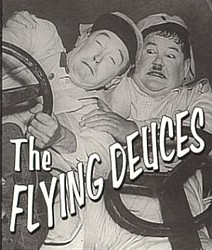
The Flying Deuces (1939 - Streaming Video) 
This was the first Laurel and Hardy movie I've ever seen and my only past familiarity with them was their posthumous animated cameo on Scooby-Doo. So, Ollie gets upset that a girl he barely knows is already married because he wanted to propose to her. His first solution is to commit suicide by attaching a rock to himself and throwing it into the river, but not before somehow convincing Stan to go down with him. But this leads to an hilarious comic routine where Stan keeps trying to delay him long enough to change his mind. Eventually Ollie does change his mind, and you might be able to guess what Stan's about to do with that rock they don't need anymore, and even if you do, it's still LOL city. (Sometimes anticipating the punchline, even when you see it coming, can make it funnier, depending on the comedic timing. That's certainly true here when both Stan and Ollie have difficulties with a curiously low ceiling.)
Ollie's change of heart arguably lands them in worse trouble because his new idea is to join the French Foreign Legion, and they don't seem to have the damndest clue what that actually entails. The duo ends up in Morocco, causes a row of trouble, and attempts to go AWOL. Their escape sequence includes a scene where they hide underneath a local man's robes, which is so hilariously implausible that at first I had no idea what was going on and was wondering why that guy had four legs when the camera panned behind him. And then I started laughing hysterically when I realized what it was.
Gee, I guess people just randomly broke out into songs in these old movies for no apparent reason. They also had a tendency to make ridiculous faces when being shot with cork bottles or when flying airplanes they don't actually know how to fly. The movie ends with the most bizarre twist I've seen in awhile, and if it seems a bit harsh, just keep in mind that the whole predicament is pretty much Ollie's fault.
I've heard that since this movie fell into public domain, various cut and edited versions have been floating around, but I'm fairly certain I saw the original uncut movie because I've heard most cut versions don't have the "shark" scene and this one did, although it looked more like a sailfish or swordfish than a shark.
Rating: 3.5/5
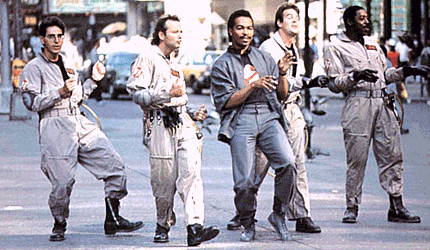
Ghostbusters (1984 - Theater) 
I finally got to see Ghostbusters on the big screen for the first time in my life, at a drive-in theater, on a Halloween triple feature with Hotel Transylvania and Monster House. If you do not know that this is one of my favorite all-time movies, then you are either new to this site or need to pay more attention.
I am also a known huge fan of the Real Ghostbusters cartoon series (at least the good episodes, anyway). It seems unthinkable that the cartoon never would have happened if Filmation hadn't sued Columbia over the use of the name "Ghostbusters", which they claimed was their trademark from an old TV series. Filmation created a cartoon based on that TV series, while Columbia created The Real Ghostbusters seemingly out of spite. But in retrospect, it's not surprising since the Ghostbusters movie was obviously not conceived as a children's film. Characters smoke, drink, swear, and there are sexual and Biblical references aplenty. Though I was never scared by the movie when I was a kid, I wonder if some scenes (like when Dana gets grabbed by the arms in the chair) would be more frightening to kids on the big screen.
I could even ask how much kids are really going to get out of a plot involving scientists being kicked out of a university, going into a private business for themselves, getting into trouble with the EPA, and battling a Sumerian god brought forth into the world by the rituals of a bizarre World War I-era cult. I could ask that, but I already have an answer - I didn't understand this movie at all when I was a kid and the most I got out of it was that a giant marshmallow man appeared at some point, and I'm not even sure I knew he was a bad guy.
But that's what's great about this movie. Multiple viewings over the years have not only allowed me to digest what's really going on, but I seem to notice new things almost every time I watch it. Only on this last viewing did I realize that the most likely reason Dana and Louis were selected to be the Gatekeeper and Keymaster was because of their apartments' proximity to a hidden staircase that led to the altar on the building's roof. Nor did I realize before now that by containing the ghosts, the Ghostbusters themselves were playing into the part of the endtimes prophecy that said Gozer would come after "all prisoners were released".
Not only does the story seem to have endless amounts of detail, but the jokes still work after all these years, and the interaction of the characters never seems to get old. Some of the special effects look a bit dated, but for the most part, they hold up exceptionally well. And of course, so does the unforgettable soundtrack, from the ever-popular, 80s-infused "Ghostbusters" theme song, to Elmer Bernstein's hauntingly ethereal score. It's no wonder the cartoon was so successful. These are characters and a concept you just can't get enough of.
Rating: 5/5

Gravity (2013 - Theater)
When I first saw the ads for this movie, I thought it was going to be "Open Water in Space". Thankfully, it goes in a much different direction beyond the initial similarities as Sandra Bullock and George Clooney become stranded in orbit above Earth after a space mission goes terribly awry.
While the movie does have thrills and the special effects are amazing, it's a bit silly that Sandra Bullock arrives at each new destination point in just enough time to do what she has to do there and escape before the hurtling tide of destructive space debris (caused by an exploded satellite) annihilates the place. There's an attempt to connect the series of action sequences to a not-so-subtle underlying theme of "rebirth" and "hope" and "letting go of the past", even having a scene of Bullock floating in zero gravity for several seconds in the fetal position as a cord floats nearby that undeniably looks like an umbilical cord, but when it's not being overshadowed by the implausible reason for her child's death, it's being undermined by the suggestion that after everything she's been through, she might have just drowned anyway.
Oh, and I saw this at a drive-in theater, and I have to wonder if there was something wrong with the audio. There were several parts where we could hear Sandra Bullock talking, but not who she was talking to. The most blatant and prolonged example was this sequence where she's talking over the radio to someone (presumably?) on Earth and starts imitating a dog howling, but we don't hear any of who or what she's talking to. I have no idea if this was an artistic decision to only have the audience hear Bullock's part of it, or if a speaker was out.
Rating: 3/5

Hotel Transylvania (2012 - Theater)
Here's yet another movie that, while not without its flaws, seems like too many critics went into it with the wrong expectations. Believing that the movie monsters would (or should) have been portrayed exactly as they are in the original horror movies and stories they came from seems a bit ridiculous when Hotel Transylvania doesn't project itself as anything other than a silly comedy/parody featuring Saturday Night Live veterans, such as Adam Sandler, Andy Samberg, David Spade, Jon Lovitz, Molly Shannon, and Chris Parnell, amongst other comedians, like Kevin James and Fran Drescher.
In director Genndy Tartakovsky's world, Dracula (Adam Sandler) is not such a bad guy after all. In fact, he has a daughter, Mavis (Selena Gomez), whom he wants to protect from humans who just don't understand monsters. On her 118th birthday, he constructs an elaborate ruse to convince her to stay forever in his castle, which negates a promise that he made to her that she could go out into the world on her own when she reached that age. Unfortunately for him, his ruse catches the attention of a human boy named Johnny (Andy Samberg) who wanders into Drac's place during the birthday party - to which all the monsters in the world have been invited. They include all the classic standbys, like Frankenstein (Kevin James), the Wolfman (Steve Buscemi), the Invisible Man (David Spade), the Mummy (CeeLo Green), their wives and children, and other weirder things. Hilarity ensues when Johnny realizes he is not at a costume ball and the monsters are for real. Complications arise when Mavis falls in love with him.
My gut feeling is that the movie will be the most meaningful for kids and for adults who grew up with the Saturday Night Live people who are in it. I did laugh at quite a few parts, but felt some of the fluff could've been trimmed. There are a number of points in this movie where you could leave to use the bathroom and by the time you got back, the only thing you would've missed is either a monster dance scene, or characters pointlessly running around as though they are a component in an invisible Rube Goldberg contraption.
The story is cute and heartwarming and all, but even as someone who was once told "the first law of the RAU (Gallery) is that no two people in a relationship can ever be the same race", and who once proselytized for a Human/Doll Demon couple in an RPG series, I'm still left wondering how things would really work out between a human and an immortal undead girl.
Rating: 3/5
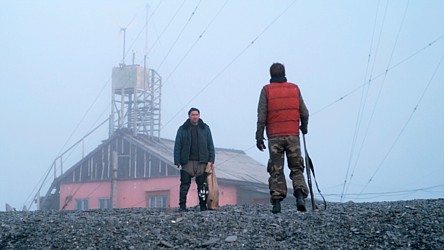
How I Ended This Summer (2010 - Streaming Video) 
Along with getting into audiobooks from the digital service, here was my first foray into borrowing a movie from it. I figured this would be a good chance to open up my horizons to some films that I probably would not otherwise see, starting with a foreign psychological thriller from Russia.
Two guys are on an desolate, isolated island in the Arctic, reporting weather information back to the mainland. One is a meteorologist who has worked there for many years and takes his job very seriously (symbolizing the "old" Soviet Union-era Russia), and the other is a grad student who's a slacker and only took the job so he could write an essay about it (symbolizing modern, "westernized" Russia). The student doesn't have any appreciation for the hostility of the environment, which is crawling with death - polar bears, harsh climate, and even a radioactive generator - or for the situation in general. This eventually leads to a conflict between the two men as they both spiral into a different sort of madness. The viewer can decide for themselves who they feel is more at fault - the student for not owning up to his responsibilities, or the old man for sometimes acting like an overbearing psycho, or perhaps they're equally at fault - a generation gap that simply has no bridge to cross over it.
The dialogue is completely in Russian, so if you hate watching subtitled movies, I doubt you'd feel much different about this one, but there's actually very little dialogue anyway. This means the movie has to get its story and ideas across almost by the visuals alone. And that's what struck me the most about the film was how beautifully shot it is. It's one of the best-looking movies I've seen in awhile, and there are pretty much no special effects. It was filmed at a real weather station on the far outskirts of Siberia, and to see that landscape is really something because I doubt most people would see anything like it in person during their lifetime. It's striking how blue the ocean and sky (not to mention various other colorful objects) are contrasted against the surrounding sheets of white ice and grey rocky ground.
Much like how I said the ending of The Magificent Seven signified the end of the Old West era in general, the ending of How I Ended This Summer feels like more than just summer has ended, but that the sun has set on the old ways of Russia and those who who have never known another way of life.
Um, only one thing...shouldn't the old man have noticed that his fish was already cooked?
Rating: 3.5/5
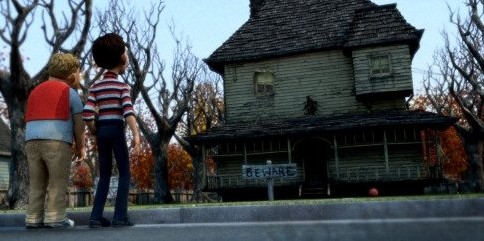
Monster House (2006 - Theater)
Monster House consistently gets higher scores from critics than Hotel Transylvania (since I saw them on the same triple feature, it's hard not to make comparisons), but I liked Hotel more because, for whatever problems it has, they aren't as headscratching or detrimental to the plot as those of Monster House.
Three kids become obsessed with the creepy old house in the neighborhood, which may or may not be haunted. The beginning of the movie suggests a credible possibility that what goes on with the house could all be in the kids' heads. Then it completely tosses that idea to the wind very randomly and abruptly. But if it is really happening, then why doesn't anyone else in the neighborhood notice it?
I also wasn't fond of the way the situation was resolved. It's like the moral was that when something becomes abusive because it was mistreated, the only thing you can ultimately do is destroy it. It just didn't sit well with me. It seemed like there should've been some way to make peace with the monster.
It turns out that script writer Dan Harmon (Community) had publicly criticized the film for the changes the studio made to his original script. I'm not surprised. I can almost imagine an alternate version of this movie being like one of those episodes of Community where something really magical or sci-fi happens, but by the end of the episode, there's an explanation and a reason for it... with maybe a hint in the epilogue that it could've been real. Instead, what we got is... a demonic, mentally-challenged fat lady who hates children, which doesn't seem like a very Dan Harmon-ish thing at all.
Rating: 2.5/5

Prisoners (2013 - Theater)
This was on a double feature at the drive-in with Gravity, and I may have liked it more up until the ending, which was very abrupt - so abrupt, that the people in the car next to us started yelling, "Bullshit!" and "Fuck that shit!". My problem wasn't so much the ending itself, but that I was waiting for an explanation of the "maze", and it never comes. I mean, a hole in the ground under a car does not, a maze, make.
So, I come home, get on the internet to find out what others thought, and lo and behold, there's a detail in the flashback sequence of the movie that explains what the maze is and then it all makes sense. I didn't notice it. Consequence of seeing it on a drive-in screen? Perhaps. But it seems a lot of other people missed it, too, and they presumably saw it under more normal circumstances. Maybe it's something you're more meant to catch on a rewatch?
Anyway, the story clearly asks you to put yourself in Hugh Jackman's shoes and inquire if you would be willing to do the same things to save your own children. It's not that I necessarily agree that what he did was right. But on the other hand, could I really feel sorry for Paul Dano? It was obvious he knew what happened to the kids. Am I supposed to feel bad because he has "the mind of a child"? If that's the real reason why he doesn't talk (though there are other theories), I find it difficult to believe he wouldn't. It's harder to keep kids quiet on things like that. Remember Balloon Boy?
I'm also in agreement with those who felt the red herring character was unnecessary and somewhat brought down the story's credibility.
Rating: 3.5/5

Secrets of Jerusalem's Holiest Sites (2007 - Streaming Video)
This National Geographic documentary is definitely helpful in making one understand the history of Jerusalem and why there's been so much fighting over it. One thing that seems oddly hopeful (even considering how much fighting and tension that still exists) is that up until recent history, whenever a faction would conquer Jerusalem, they would conquer it completely and keep anyone else out. But now there are three religions currently residing and holding power, Christianity, Islam, and Judaism, and it's been that way for awhile, like a three-way stalemate. The film explains each religion's perspective and background, complete with recreations of scenes from the Bible and history, but doesn't side with any of them.
The cinematography is beautiful and made me wonder if it was done with high dynamic range. The colors are astounding, and although CGI is used to recreate some scenes (such as one that shows how the city was built), it's almost hard to believe the view inside the Dome of the Rock was not CGI, considering how colorful it is.
The only problem is that a secular person, or perhaps anyone who follows a belief system different from those portrayed in the film, might come away from it thinking that the whole ordeal is basically people fighting over rocks. I know, I'll probably offend some people by saying that, but that's literally what's going on - there's a bunch of different rocks in Jerusalem that are considered sacred for various (usually Bible-related) reasons and every religious faction wants exclusive rights to worship them. There's also this thing about how the Wailing Wall is the most sacred part of the city, but the secret part of the wall is even more sacred, and the hidden chamber underneath is even more sacred still. Oy vey, indeed.
Rating: 3/5

Star Wars Episode IV: A New Hope (1977 - DVD) 
While it's true that I reviewed this movie way back in my 2010 capsules, this time I watched the original version, as opposed to the Special Edition. (The one that doesn't even say "Episode IV: A New Hope" on the title card.) There is nothing like seeing this movie as it was originally presented, without all the goofy changes made to the special editions, and without thinking about what the series would become with the prequels.
What I believe made this movie work so well and have the cultural impact that it did is its solidly-structured plot and memorable scenes. The plot, actually, is very simple. It's not some convoluted political mess, it's basically, "get the plans to the Death Star; save the princess; destroy the Death Star". The beginning of the movie, set on the lawless desert planet of Tatooine (which, incidentally, is never named in this film), is like a western in disguise. Eventually, the action moves into space, with a frantic rescue aboard the immense Death Star space station, and concludes with what was then, and may even still be now, the most thrilling space battle in movie history.
We're also introduced to great characters, from Luke Skywalker's humble beginnings as a poor farmboy to his eventual rise to hero status as he learns the ways of the Jedi knights. While I'm sure a feminist or two will groan at the "rescue the princess" part of the plot, as it turns out, Leia is very capable of handling herself in tough situations. Alec Guiness as the wise old Jedi master Ben Kenobi brings an air of sophistication to what might otherwise be seen as a silly sci-fi plot. And who's going to argue that Darth Vader isn't one of the greatest movie villains of all time? But perhaps most important of all is Han Solo, who is the audience's in-road. As the skeptic, and the most pragmatic character, he is the one we most easily identify with and, as some might argue, maybe even the real hero of the story. (This is something I felt the prequels were lacking.)
As I was watching this movie again for what is probably the 50th time by now, I noticed that I could see the rectangles around the ships while they were flying against the darkness of space (particularly during the climactic Death Star battle at the end), and I wondered... why not just have cleaned up stuff like that in the special editions and left everything else alone? But I'll still take slightly noticeable rectangles around ships over Greedo shooting first anyday.
Rating: 5/5

Star Wars Episode V: The Empire Strikes Back (1980 - DVD) 
I will not deny that Empire is a great movie, a totally worthy sequel to Star Wars, and deserving of its place in the series and many of the accolades it has received. However, and I do apologize for this next part, I am not 100% sold on the idea that it's the best one. Because, well, it really doesn't work as a standalone story (no conclusive ending) the way the first one does, and a chase through an asteroid belt isn't quite the same as the epic life-or-death battle of the rebel forces against the Death Star. I can understand thinking the beginning of A New Hope is a little slow when it's mostly about two droids wandering around lost in a desert, but the beginning of Empire is just an elaborate explanation for the scars on Luke's face (caused when Mark Hamill famously got into a car accident years earlier).
With that out of the way, Empire did introduce some of the most memorable characters in the Star Wars universe, including the wise old Jedi master, Yoda (who provides some levity amidst the movie's generally darker tones); gambler-turned-baron of a fantastic mining city suspended in the clouds, Lando Calrissian (though his star would not truly shine until the next installment); everyone's favorite yet mysterious bounty hunter, Boba Fett; and our first glimpse of the mysterious Emperor Palpatine.
Though as I said, nothing quite measures up to the Death Star battle, the action sequences of Empire take the same creative and thrilling approach by having rebel forces find unique ways of fighting against impossible odds - everyone remembers how they bring down the lumbering AT-AT walkers by tripping them with cables - with special effects that were state-of-the-art for their time (and many will argue, even better than modern CGI).
Though the movie doesn't have as conclusive an ending as the first or third entries, perhaps it didn't need one because what could seriously top the bombshell of a plot development right before it? I'll hold off spoilers for the one person who's been living under a rock, but finding out you-know-who is you-know-who's father must've made 1980 audiences shit an entire chimney.
For this outing, I watched the Special Edition, because the changes here aren't quite as intrusive or stupid. Forgive me if I actually want to see a Wampa in a scene where Luke is attacked by a Wampa.
Rating: 4.5/5
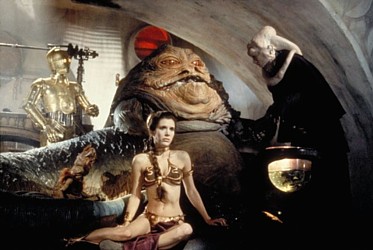
Star Wars Episode VI: Return of the Jedi (1983 - DVD) 
And finally, here we go, the black sheep of the original trilogy. I feel like my opinion on Jedi is exactly comparable to my opinion of Temple of Doom - even if it is the weakest in the series and has some questionably goofy material, it's still a worthy addition with much of the same feel and quality of action and special effects as the other two in the series. Having seen the movie when I was a kid probably went a long way towards my inability to be bothered too much by the Ewoks. Personally, I feel too big a deal is often made of the little teddy bear-like creatures' ability to defeat the Empire's forces when considering that until Chewbacca took control of an AT-ST, which turned the tides in their favor, they were getting their asses kicked. And, seriously, screw you if you don't think the Ewok Village is an iconic and memorable setting.
In many ways, Jedi is a remake of the first movie. Once again, we start with the droids in the Tatooine desert, interacting with a bunch of crazy aliens - in this case, the many weird inhabitants of gangster (and Han Solo antagonist), Jabba the Hutt's palace. Ultimately, they have to blow up another Death Star. If the space battle doesn't quite recapture the magic of the first movie's Death Star fight (though we all love Admiral Ackbar and his "It's a trap!" line), at least the view of the space station's core (especially on the big theater screen, if you've been so lucky to see it that way) is breathtaking. And Lando from Empire really gets to shine here. Sometimes I love it when tertiary characters have their breakthrough moments, and you couldn't ask for a more monumental one than this.
Anyway, if I felt Empire Strikes Back didn't have a conclusive ending, I certainly can't have that same complaint here. Love or hate what George Lucas did with the final entry, at least he made it go out with a bang. Luke's dramatic confrontation with the creepy Emperor carries over much of the same dark connotations from Empire. If the revelation of Darth Vader's true relationship to Luke was a head-spinner, the twist involving him at the end of this movie practically one-ups it. I do agree that Leia turning out to be Luke's sister is farfetched, but I didn't really see them as ending up together anyway since Leia admitted to being in love with Han by the end of Empire.
BTW, the original version is the only way I will watch Return of the Jedi now. If you think I'd willingly sit through that embarrassing "Jedi Rocks" dance scene, or the new ending that painfully shoehorns stuff from the prequels into it (especially Hayden Christensen's "ghost" replacing Sebastian Shaw), then you're crazier than I.
Rating: 4/5
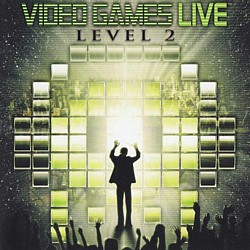
Video Games Live: Level 2 (2010 - Streaming Video)
Video Games Live is a symphony performance of various video game songs, hosted (and produced) by Tommy Tallarico, who also plays electric guitar on some songs. Despite the "Level 2" in the title, there is no "Level 1", this is the only video there is, which originated as a PBS special. Footage of the games whose music is being played is shown interspersed between clips of the orchestra and on video screens in the background. It was okay, but it could've been better.
In general, the concert is more friendly to fans of modern games than oldschool games, though ironically, I felt the best parts were the oldschool game montages, Mega Man, Sonic the Hedgehog, Super Mario Bros., and an awesome solo piano performance of Tetris music. Unfortunately, I felt the Legend of Zelda part was disappointing. While everything else got a three-song medley, Zelda was just the main Zelda theme, a made-up slow part in the middle, and then the Zelda theme again. C'mon, folks, Zelda Theme - A Link to the Past's Dark World Theme - Gerudo Valley. That would've been perfect. And the Castlevania medley was good, but seriously... No Bloody Tears??
Most of the modern games seem like they were chosen more for their popularity than because they are known for having great soundtracks (I've never heard anyone talk about Myst's music, yet here it is), and almost all of them have sweeping, orchestral scores that are more akin to the adagios of classical works than the upbeat parts that people actually remember. Aside from God of War, I couldn't recall a single melody from any of them once the concert was over, and I'm the type of person who loves discovering new game music, so I was hoping I'd get something more out of this than I did. I think part of the problem was that they weren't able to use much of Square's music aside from one Chrono Cross song.
Also, for some inscrutable reason, instead of maybe including more music, they interviewed Jamie Lee Curtis (?!) who goes on about how James Cameron's Avatar stole from World of Warcraft. So, then they show footage from World of Warcraft and, lol, it doesn't look anything like Avatar, but it does look a lot like Peter Jackson's Lord of the Rings, even having a dwarf that heavily resembles John Rhys-Davies as Gimli. Considering the awkwardness of how much the Halo footage in the beginning looked like scenes taken from James Cameron's Aliens, I would have kept mum on this and not drawn attention to it.
Rating: 3/5



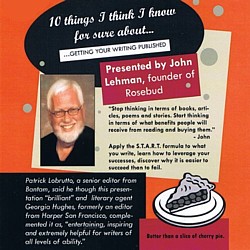
10 Things I Think I Know For Sure About...Getting Your Writing Published (2009 - Audiobook)
Author & Reader: John Lehman
Because I had been giving some serious thought to becoming a published writer, I decided to check out this audiobook to see if its advice would be of any worth to me. This book does not have a print version. It is basically professional writer/author John Lehman recording his thoughts and knowledge on the subject in an organized list. There is a lot of really good advice on here and until you listen to something like this, you may not truly understand how trying to get your work published can become a fulltime job in and of itself, and one that you won't get paid for. I would not say the book is discouraging, but it's sobering - and it outright confesses that oftentimes it comes down to being lucky enough to be in the right place at the right time (though it does, to the best of its ability, offer advice on how to be in the right place at the right time).
But there are a few issues one should consider. The first is that things have changed dramatically since the book was recorded in 2009. While it does touch briefly on the idea of self-publishing via the internet, I think that has become even easier and more commonplace these days than it was back then, and perhaps more acceptable. So, if you feel the suggestions in this book are beyond your ability to do, you may as well go the self-published route, especially if you want faster results.
The second is that you may not want to take all of the book's advice too seriously. One chapter suggests you and your spouse should write for 20 minutes a night, then read each other's work and critique it. That, #1, assumes you have a spouse or partner at all, and #2, assumes they'd be willing to do this. I have a feeling that even if a writer is lucky enough to have a partner who is also a writer, they may not be willing to submit to an activity that feels like work, for which the other party should not be surprised or disappointed. And I know from personal experience that sometimes two writers, no matter how good both may be, will not see eye-to-eye on certain things. Sometimes you have to listen to criticism, but other times you have to trust your own feelings. Having someone tell you night after night that your work is all wrong just for the sake of offering criticism could get maddening and discouraging.
That silly chapter aside, I can easily recommend anyone interested in being a published writer to check their local library for this title. At only an hour and eighteen minutes, it won't even take you that long to get through it, so you really have nothing to lose.
Rating: 3/5
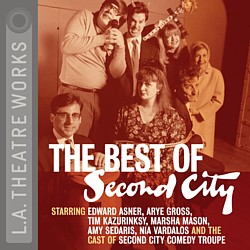
The Best of Second City (2005 - Audiobook) 
Despite that this is a recording of a radio show and not a reading from a book, it's still considered an audiobook. Releasing old radio show recordings as audiobooks is actually a common practice, but this was the first one I'd listened to. I know very little about Second City, and mostly only that it's a sketch comedy where some now-famous comedians got their start. This recording is basically like an audio-only version of a "Best of Saturday Night Live" DVD. Much like those compilations, it contains some genuinely funny bits and some duds. Some of the funniest sketches involve the "teacher teaching a class full of stupid students" trope, which is commonly utilized by comedy writers, including myself. A slight variation on this theme is a sketch where a career counselor attempts to counsel people who aspire to very unrealistic careers, which I almost thought I'd have to stop listening to because I didn't want to be laughing out loud like a maniac at work.
One problem with the audio vs. video format is that aside from Ed Asner, whose voice I know from his various cartoon roles, I was never quite sure of who was who. I tend to think Steve Carrell has a very distinct voice, but I never knew when it was him or Steve Colbert. I'm not sure why that is. Since they're both named Steve, it didn't help when the other performers mentioned them by name.
Random observation: There was one sketch where one of the women performers had to guess a common phrase by the clues she was given from the others acting them out. I am so glad I am not her, because I never would've gotten it - I had never heard the phrase "make hay while the sun shines" before in my life.
Rating: 3.5/5
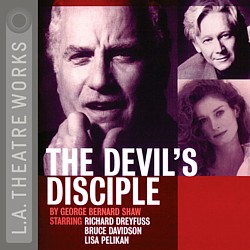
The Devil's Disciple 
Author: George Bernard Shaw; Reader: Full Cast
(Audiobook - 2001; Original Play - 1897)
A full cast production of George Bernard Shaw's play that features actor Richard Dreyfuss, although only in a brief, but very important role near the end. I wondered before borrowing this if I'd have trouble following it since it's almost pure dialogue, I wouldn't get the benefit of any visuals, nor any additional information that would be in the written version of the play. But it turns out that it wasn't difficult to understand or follow at all. Since it's only an hour and a half long, I listened to it twice and found it very entertaining both times. I can tolerate having a single reader for books, but plays definitely benefit from having multiple actors, especially of the correct gender for the roles.
Set in 1777 New Hampshire during the American Revolution, Richard Dudgeon returns home to find that his recently-deceased father has left him almost the entire estate. Richard is considered an outcast by his family because of his claim to follow in the ways of the Devil instead of God. The Reverend Anderson is the one person who treats Richard with respect, despite their opposing religious views. When British soldiers arrive to arrest and hang Anderson, they accidentally capture Richard in error, not realizing they have the wrong guy. Richard pretends to be Anderson so as to save his life, for reasons even he isn't quite sure of.
I think Shaw's lesson here is that morality and heroism isn't defined by one's religion, but is something that is inherent to man. (It was no surprise to me that Shaw was an atheist.) It must've been a pretty bold card to be playing in 1897, yet this play was Shaw's first financial success and the one that put him on the map. But it's not hard to understand why. The dialogue is clever and witty (I had to be careful not to laugh too hard at the way Richard toys around with the British soldiers during the trial since I was listening to it at work), and the story oozes irony as almost every main character (not just Richard) turns out to be something almost completely opposite of what they thought they were. There is also a general consensus amongst all the non-British characters that being an American is like being part of something that's greater than the sum of its parts, which I'm sure goes over quite well with American audiences of all decades.
Rating: 4/5
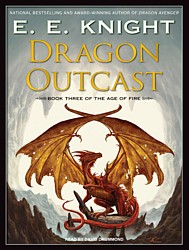
Dragon Outcast: Book Three of the Age of Fire
Author: E.E. Knight; Reader: David Drummond
(Audiobook - 2009; Original Book - 2007)
So, I now have 22 downloads per month at the digital borrowing service, and I got tired of checking out nothing but albums, so I entered the world of audiobooks. My thinking was that it might take some time to get used to the idea of someone reading a book to me as I work, and because of that, I wanted to "practice" before diving into any classic works of literature. Cutting my teeth on a fantasy novel may not have been the best idea in the world, either, but the premise of this book sounded interesting - a dragon who becomes an outcast after being crippled by his nestmates rises to ultimate power in the dragons' kingdom, not by being the strongest or the one with the most powerful flames, but by his cunning, intelligence, and being the voice of reason. I admit that I am kind of a sucker for underdog stories and I hadn't quite heard of this thing done with a dragon before.
First of all, I had no idea this was Book Three in a series because the print was so tiny on the preview image, I couldn't read it until after I borrowed it. But it doesn't matter as it's almost entirely self-contained. The story is so bizarre in places that it's hard to imagine it ever being adapted into anything like a movie or TV series. For example, the outcasted dragon (most often referred to as "The Copper") befriends a large group of vampire bats who help him find his way through the caves, and he returns their favor by letting them "leech" blood off of him (and this even becomes a major plot point later). The author also has no bones about describing the scatological stuff. That's something I think most writers, even if they want to write about their subject realistically, tend to leave out. Not E.E. Knight. Dragons and various other creatures dump it, throw it, even brag about it.
Narrator David Drummond does a fine job with different accents for the various characters, and he lucked out on this one in that the only major female human character is mute. I didn't mind so much that the female dragons sounded like a man imitating a female voice because, who knows? Maybe that's what a female dragon would sound like anyway.
While somewhat episodic in nature, the book has many memorable moments (I still have this image in my head of a dragon divebombing off a cliff and bringing down a stone fortress stronghold by skipping giant boulders at the walls), but I didn't think the ending made much sense. I don't want to spoil it, but I can say it seemed rather abrupt and like the dragons all did a 180 on something they were completely opposed to without any explanation. I wonder if maybe the author had a deadline to make and it was approaching at that point.
Rating: 3.5/5

The Meaning of It All: Thoughts of a Citizen-Scientist
Author: Richard P. Feynman; Reader: Raymond Todd
(Audiobook - 2007; Original Lectures - 1963)
This book is a collection of three lectures that Nobel Prize-winning physicist Richard P. Feynman gave at the University of Washington in 1963. While it is a very entertaining listen, and perhaps of interest to his fans, I get the feeling it might be a little duh-duh to those who already know a lot about science and how it works because much of the beginning is him explaining in layman's terms what it is. Then, beyond that, he goes off on rants attacking all kinds of random things, from astrology, to belief in UFOs, to the existence of God, to Khrushchev's taste in art, and English teachers for not changing the spelling of "friend" to "frend" because too many people spell it wrong. It's funny, and informative, and I can't help but agree with him on most points, but I'm wondering if the reason Feynman did not want these lectures published while he was still alive is because he may have had second thoughts on some things. The entire psychology department famously got up and walked out when he compared their profession to "witch doctors". That's one detail you wouldn't get from this book alone and would only know from other sources.
I imagine there are other things we are missing out on by listening to an audiobook version of these lectures read by someone other than Feynman himself, who was known for being very charismatic. You don't get his personal inflections nor the audience reactions. It's not that there's anything actively wrong with Raymond Todd's reading, but he's not Feynman, and apparently audio recordings of these lectures exist, so why even involve a middle man and not just have released them as they are?
Rating: 3/5
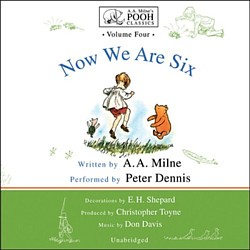
Now We Are Six: A.A. Milne's Pooh Classics Volume Four 
Author: A.A. Milne; Reader: Peter Dennis
(Audiobook - 2005; Original Book - 1927)
This is an absolutely adorable and irresistible reading of the fourth book of A.A. Milne's classic Winnie the Pooh poetry. (Pooh makes a guest appearance in some of the poems, but most of them actually have nothing to do with him.) Though these poems are intended for children, they are not without entertainment value for adults. Milne's wordplay, rhyme schemes, and rhythm is so ingenious it holds appeal for all generations. When he has to make up a word to fit a rhyme, such as using "snew" as a past tense of "snow", we not only forgive it, we totally love it. A part of me even wonders if adults will get more out of this than the six-year-old audience it's intended for. While some of the poems are short and simple and about a single idea, some of the longer ones actually tell rather complex stories. There's even one, "Explained", that ruminates on the existence of God.
The audiobook is only an hour and a half long, but I loved it so much, I listened to it twice in a row. Peter Dennis's reading is fantastic. Although his Pooh sounds much different from the well-known Disney version, it's still an acceptably lovable take on the character.
Rating: 4/5
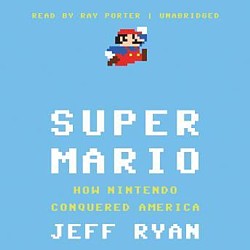
Super Mario: How Nintendo Conquered America 
Author: Jeff Ryan; Reader: Ray Porter
(Audiobook & Original Book - 2011)
When I found this audiobook on the digital service, my finger couldn't hit the "borrow" button fast enough. It's a really good listen, but not without its flaws.
When it's talking about the history of the company, and the people involved with it, it's pretty much dead on the rails. It's hard not to feel uplifted at the point when Donkey Kong becomes a big hit, considering how much Nintendo and its employees (especially those in America trying to make the game a reality) had to go through for it. I admit to getting a little choked up.
For the most part, with the exception of a few things even the author felt were crossing the line, the book is in favor of Nintendo. With a sort of Underdog/Hero/Fall From Grace/Comeback structure to everything, you're almost always rooting for them. (It actually made me feel a little guilty about slacking off with my Nintendo support midway through the Gamecube's life.)
There are, however, a few parts where the book takes an odd stance on things, which even tends to be contradictory to itself. For example, it called Yoshi's Safari an "embarrassment" and said it was too out-of-character for Mario to be shooting at his enemies. Uh, yeah, but the book had already subscribed to the notion that Mario is a jack-of-all-trades who can be shoehorned into any situation. As far as light gun games go, it's about as cartoony and Mario-like as possible. And if you buy an expensive peripheral like the Super Scope, you're going to want games for it. The book established that Mario sells games. So, it seems like a Mario light gun game is a no-brainer for selling more Super Scopes.
Also strange was its criticism of Donkey Kong '94. The author felt Nintendo should've been concentrating on making games for a CD system, not for the Game Boy. Uh, but just before that, it made a point to mention that the Sega CD was a big flop and how awful the Philips CD-i was. Why should Nintendo have then been so worried about making an add-on when the competitors' failed? The book also fails to mention the main point of DK'94 was to show off the Super Game Boy capabilities, which it doesn't talk about at all. Plus, once again, you know, the Game Boy was lacking in great games, and DK'94 is a pretty damn good game.
Anyway, I learned some very interesting things from this book, such as how the idea for Donkey Kong came from Popeye (and no doubt some King Kong influence, too, but no, seriously, it was Popeye - Popeye, Olive Oyl, and Bluto were transmogrified into Mario, Pauline, and Donkey Kong when they couldn't secure a license to make a Popeye game). I also learned that the reason Nintendo seems more lax on going after ROM sites and fan hacks lately might be due to their current president feeling that it's not appropriate to do so.
However, the end of the book was trying to shove in too many ideas that it doesn't fully explore. It touches very briefly on the "Are Games Art?" argument, but all it really does is say what Ebert thought and Miyamoto thought (both said no) and what some other journalist who said yes thought. It also threw an unnecessary bone to feminists when, for no real reason, it said that all women in video games dress like strippers, despite the counter-examples mentioned in the book itself.
It may not be entirely friendly to people who know nothing about video games. It often mentions technical things like emulators without explaining what they are. But that's a minor complaint considering the people who will get the most out of the book are those that already do have game knowledge. Of greater concern is that sometimes it gets minor details about the actual games wrong. For example, it explains how Super Mario Bros. 2 is a port of Doki Doki Panic, but the author mistakenly thought that Wart had been replaced with Bowser as the final boss, just as the four main heroes had all been replaced with the Mario characters. It also explains why Final Fantasy VII and Dragon Warrior VII went to the Playstation instead of the N64, but makes it seem like Square was responsible for both, without a single mention of Enix, who had released DWVII before the merger.
But those concerns aside, I generally had a good time listening to this book and would recommend any fan of oldschool gaming and Nintendo to check their library for either the audio or print edition.
Rating: 4/5







